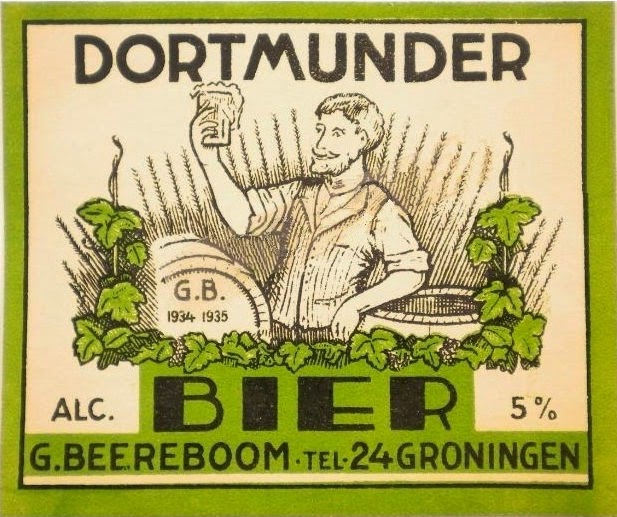I've a busy time coming up, travelling to the US twice, giving talks and writing them, too. Realising I'd have little time to blog, I wrote a whole string of posts. Leaving me time to concentrate on all my other activities.
One of which is writing a talk on Dutch Lager styles. That's kept me busy for a week or so. The research has been fun and instructive. Too much fun. It's hard to know when to stop. I keep unearthing more and more in the Dutch newspaper archive.
What I've learned is that there were once many more styles of Lager brewed in Holland. Most are long gone, pushed out of the pram by their ambitious sibling Pilsener. Despite the recent boom in new breweries, Pils is still probably 90% of Dutch beer consumption. But when did it become so dominant?
I've found a partial answer. In the brewing records of Heineken's Rotterdam brewery.
 |
| Nieuwe Tilburgsche Courant, 27th October 1937, page 4. |
The key to the solution was Heineken's way of brewing. The batch sizes for each type of beer were the same every time. And not only is each brew numbered, they also keep track of how many times each type of beer was brewed. Multiply the batch size by the number of brews and you have the total annual quantity.
Or I would if I had photographed the last page of the brewing year (the end of September). But I didn't. But I do have ones from two-thirds of the way through. Good enough to see the proportions brewed of each type. Except for Bok. The percentage for that in the table below is too high because they include every brew, while for the other types it's only two thirds of the brews.
I've figures for two years. First, 1911:
| Heineken Rotterdam production by type in 1911 | ||||
| type | no. of brews | size of brew (HL) | total amount | % of total |
| Lager | 226 | 270 | 61,020 | 36.13% |
| Gerste | 356 | 220 | 78,320 | 46.37% |
| Beiersch | 28 | 200 | 5,600 | 3.32% |
| Pils | 107 | 200 | 21,400 | 12.67% |
| Bok | 17 | 150 | 2,550 | 1.51% |
| total | 734 | 168,890 | ||
| Source: | ||||
| Heineken brewing record held at the Amsterdam Stadsarchief, document number 834-1752. | ||||
The most popular types were Lager, a pale 10º Plato beer and Gerste. Gerste is a funny one. It was one of the pre-Lager top-fermenting Dutch styles which had transformed itself into a Lager.
Baartz, of Oranjboom in Rotterdam, described Gerstebier in 1884 like this "although a bottom-fermented beer, it is of a low gravity and not lagered, and is a beer quick to make for a significantly lower price"*. It was also dark in colour. It was stronger than the Lagerbier at 12º Plato. Between them, these two beers accounted for over 80% of Heineken's production.
Pils was a measly 13%. Beiersch, a full-strength Dark Lager couldn't even manage 5%.
Look how things had changed by 1929:
| Heineken Rotterdam production by type in 1929 | ||||
| type | no. of brews | size of brew (HL) | total amount | % of total |
| Licht | 95 | 440 | 41,800 | 14.46% |
| Donker | 48 | 770 | 36,960 | 12.79% |
| Bayerisch | 41 | 295 | 12,095 | 4.19% |
| Pils | 491 | 395 | 193,945 | 67.11% |
| Bok | 21 | 200 | 4,200 | 1.45% |
| total | 696 | 289,000 | ||
| Source: | ||||
| Heineken brewing record held at the Amsterdam Stadsarchief, document number 834-1754. | ||||
1911's most popular beer, Gerste, has disappeared completely. The output Licht - effectively the same beer as Lager - had dropped by more than 50%. The big winner being Pils, which was two-thirds of everything brewed.
That's quite a turnaround. Unfortunately, I haven't figures for the intervening years. I can't pin down an exact date for the boom in Pilsener's popularity. My guess is just after WW I.
* "Korte Geschiedenis der Heineken's Bierbrouwerij Maatschappij N.V. 1873 - 1948", by H. A. Korthals, 1948, page 96.












































































7 comments:
When I run "gerste" through Google Translate, it equals barley. Is this right? Does this mean there was difference between "barley beer" and regular "beer"? This could help out Alan and Craig with the Albany Beer Project.
The Gerste sounds intriguing, a 12 degree Plato, dark top fermented beer that became a bottom fermented beer? Where does that sound familiar from...?
Ed,
yes, it just means barley. I've not heard of any beers brewed from other grains in the second half of the 19th century in Holland.
It just seems to be a name at this point, with no particular reference to its characteristics.
Velky Al,
you're thinking of Bohemian beers, aren't you?
Ron,
Nothing new there then!! ;)
By the way, looking at that price list, aren't Gerste and donker the same beer? So rather than disappearing completely, it would appear that production of that beer halved, while overall production dramatically increaded.
Velky Al,
Donker and Gerste aren't the same beer. Donker was under 10º.
Nice to see Stout on offer.
Post a Comment